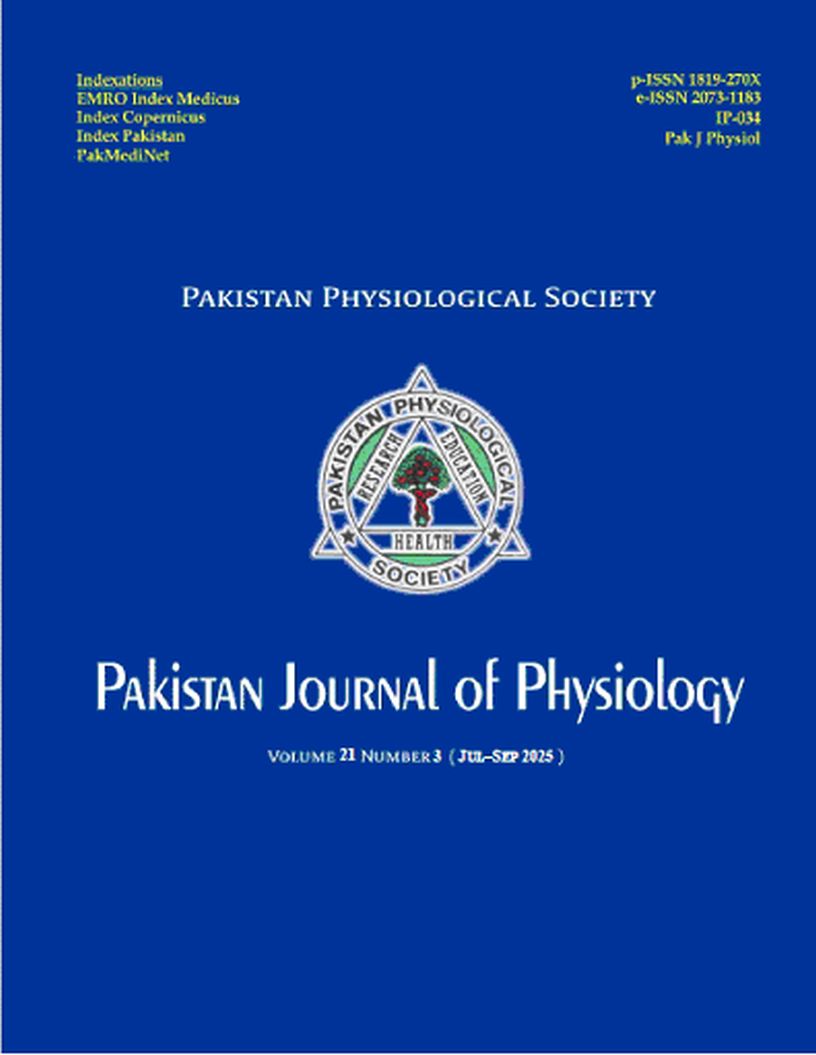COMPARISON OF ESTRADIOL LEVELS IN RAT MODEL OF CHRONIC ALTERNATING STRESS
DOI:
https://doi.org/10.69656/pjp.v21i3.1864Keywords:
Chronic Alternating Stress, Corticosterone, EstradiolAbstract
Background: Stress is a prevalent factor in our daily lives and is affecting the reproductive system too. The objective of this study was to compare the effect of chronic alternating stress on two generation of rats by evaluating the corticosterone and estradiol levels. Methods: One hundred and thirty-six healthy wistar albino rats 11 weeks old were used in this experimental case-control study. They were distributed into case and control parent groups after assaying for baseline parameters. Case parents were given three weeks of chronic alternating stress while the control parents were not given any stress. Following mating within respective groups the offspring were placed into 5 groups each. One group was assayed at 5 weeks without any stress, the other was given 3 weeks of stress and assayed at 8 weeks, the third group was given stress at the age of 5 and 11 weeks, one group was given stress only at 11 weeks of age. There were two control groups which were offsprings that did not receive any stress and were assayed at the ages of 8 weeks and 11 weeks. Blood sera were assayed for corticosterone and estradiol using Enzyme Linked Immunosorbent Assay Techinique. In the offspring generation behavioural tests were done and analysed. Results: The rats given early life stress had raised corticosterone levels and decreased estradiol levels shown by significant p-values. Conclusion: The early life stressed rats did not fare well as compared to rats given repeated stress.
Pak J Physiol 2025;21(3):41–45, DOI: https://doi.org/10.69656/pjp.v21i3.1864
Downloads
References
Tan SY, Yip A. Hans Selye (1907–1982): Founder of the stress theory. Singapore Med J 2018;59(4):170–1.
Sharma K, Akre S, Chakole S, Wanjari MB. Stress-Induced Diabetes: A Review. Cureus 2022;14(9):e29142.
Kubera B, Kohlmann T, Peters A. Psychological stress, body shape and cardiovascular events: Results from the Whitehall II study. Compr Psychoneuroendocrinol 2021;9:100104.
Van der Valk ES, van der Voorn B, Iyer AM, Mohseni M, Leenen PJM, Dik WA, et al. Hair cortisol, obesity and the immune system: Results from a 3 year longitudinal study. Psychoneuroendocrinology 2021;134:105422.
Alameda L, Rodriguez V, Di Forti M, Spinazzola E, Trotta G, Arango C, et al. The effect of polygenic risk score and childhood adversity on transdiagnostic symptom dimensions at first-episode psychosis: evidence for an affective pathway to psychosis. Transl Psychiatry 2024;14(1):454.
Ge L, Liu S, Li S, Yang J, Hu G, Xu C, et al. Psychological stress in inflammatory bowel disease: Psychoneuroimmunological insights into bidirectional gut-brain communications. Front Immunol 2022;13:1016578.
Amini-Khoei H, Haghani-Samani E, Beigi M, Soltani A, Mobini GR, Balali-Dehkordi S, et al. On the role of corticosterone in behavioral disorders, microbiota composition alteration and neuroimmune response in adult male mice subjected to maternal separation stress. Int Immunopharmacol 2019;66:242–50.
Sanogo F, Jefferson M, Beard TA, Salhia B, Babatunde OA, Cho J, et al. Social and clinical drivers of stress responses in African American breast cancer survivors. Sci Rep 2024;14(1):19729.
Xu HX, Lin SX, Gong Y, Huo ZX, Zhao CY, Zhu HM, et al. Chaiyu-Dixian formula exerts protective effects on ovarian follicular abnormal development in Chronic Unpredictable Mild Stress (CUMS) Rat Model. Front Pharmacol 2020;11:245.
Beeton C, Garcia A, Chandy KG. Drawing blood from rats through the saphenous vein and by cardiac puncture. J Vis Exp 2007;(7):266.
Fonken LK, Finy MS, Walton JC, Weil ZM, Workman JL, Ross J, et al. Influence of light at night on murine anxiety-and depressive-like responses. Behav Brain Res 2009;205(2):349–54.
Agrawal A, Jaggi AS, Singh N. Pharmacological investigations on adaptation in rats subjected to cold water immersion stress. Physiol Behav 2011;103(3–4):321–9.
Padovan CM, Guimaraes FS. Restraint-induced hypoactivity in an elevated plus-maze. Braz J Med Biol Res 2000;33(1):79–83.
Brown GR, Nemes C. The exploratory behaviour of rats in the hole-board apparatus: Is head-dipping a valid measure of neophilia? Behav Processes 2008;78(3):442–8.
Kacharava T, Nemsadze K, Inasaridze K. Elevated level of prenatal testosterone and vitamin D3 deficiency during pregnancy, in the presence of prenatal maternal stress, and their association with the development of attention deficit hyperactivity disorder (ADHD)-like symptoms in toddlers. Pediatr Endocrinol Diabetes Metab 2024;30(2):69–73.
Lipner E, Murphy SK, Ellman LM. Prenatal maternal stress and the cascade of risk to schizophrenia spectrum disorders in offspring. Curr Psychiatry Rep 2019;21(10):99.
Xu X, Miao Z, Sun M, Wan B. Epigenetic mechanisms of paternal stress in offspring development and diseases. Int J Genomics 2021;2021:6632719.
Zhou XM, Liu CY, Liu YY, Ma QY, Zhao X, Jiang YM, et al. Xiaoyaosan alleviates hippocampal glutamate-induced toxicity in the CUMS rats via NR2B and PI3K/Akt signaling pathway. Front Pharmacol 2021;12;586788.
Zhang Y, Gu F, Chen J, Dong W. Chronic antidepressant administration alleviates frontal and hippocampal BDNF deficits in CUMS rat. Brain Res 2010;1366:141–8.
Toth E, Gersner R, Wilf?Yarkoni A, Raizel H, Dar DE, Richter?Levin G, et al. Age?dependent effects of chronic stress on brain plasticity and depressive behavior. J Neurochem 2008;107(2):522–32.
Henry C, Kabbaj M, Simon H, Moal M, Maccari S. Prenatal stress increases the hypothalamo-pituitary-adrenal axis response in young and adult rats. J Neuroendocrinol 1994;6(3):341–5.
Carrasco RA, Breen KM. Allostasis in neuroendocrine systems controlling reproduction. Endocrinology 2023;164(10):bqad125.
Toufexis D, Rivarola MA, Lara H, Viau V. Stress and the reproductive axis. J Neuroendocrinol 2014;26(9):573–86.
Roney JR, Simmons ZL. Elevated psychological stress predicts reduced estradiol concentrations in young women. Adapt Hum Behav Physiol 2015;1(1):30–40.
Downloads
Published
How to Cite
Issue
Section
License
Copyright (c) 2025 Madiha Khattak, Robina Usman, Muhammad Omar Malik, Muhammad Luqman, Fazlina Shaid, Ammara Khattak

This work is licensed under a Creative Commons Attribution-NoDerivatives 4.0 International License.
The author(s) retain the copyrights and allow their publication in Pakistan Journal of Physiology, Pak J Physiol, PJP to be FREE for research and academic purposes. It can be downloaded and stored, printed, presented, projected, cited and quoted with full reference of, and acknowledgement to the author(s) and the PJP. The contents are published with an international CC-BY-ND-4.0 License.











